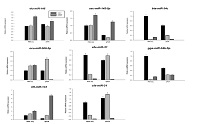Reproduction, Fertility and Development
Volume 32
Number 12 2020
The development of a healthy oocyte within the ovary is critical for human fertility. This study found that members of the Janus kinase (JAK)/signal transducer and activator of transcription (STAT) signalling pathway are expressed in the human ovary, specifically in the cells that support oocyte development. These results highlight the need for a greater understanding of ovarian signalling and what the consequences are for female fertility.
Irradiation deteriorates sperm count and quality, and may affect future generations. Administration of lycopene (LYC) at different times after the irradiation of mice ameliorated the harmful effect of irradiation on gametes. Mitigation of radiation-induced damage by LYC may be useful for radiological accidents and to protect non-treated tissues in patients with cancer undergoing radiotherapy.
2,3′,4,4′,5-Pentachlorobiphenyl (PCB118) is an oestrogen-like, environmentally persistent organic pollutant that can enter the human body through the food chain and damage an animal’s reproductive system. Exposure of mice to PCB118 during pregnancy was found to have adverse effects on the reproductive system of male offspring, and this effect may be passed on to future generations. This suggests that more attention should be paid to the potential effects of PCB118 on human health, as well as on the offspring.
Thyroid hormone (TH) plays critical roles in the development of ovarian follicles. This study investigated the effect of TH on ovarian apoptosis. Dysregulation of TH induced granulosa cell apoptosis in the rat, which was accompanied by decreases inglucose-related protein 78 (GRP78) expression and increases in C/EBP homologous protein (CHOP) and cleaved caspase-3 in the rat ovary. Moreover, equine chorionic gonadotrophin treatment not only changed the expression of GRP78, CHOP and cleaved caspase-3, but also improved ovarian cell apoptosis in hypo- and hyperthyroid rats.
To characterise microRNA (miRNA) expression in different regions of the epididymis, RNA sequencing (RNA-seq) was used to examine miRNA expression in the caput, corpus and cauda epididymidis of the yak. Differentially expressed miRNAs were detected among the various region pairs, and gene ontology and Kyoto Encyclopedia of Genes and Genomes (KEGG) pathway enrichment were used to identify predicted target genes. To validate the repeatability and reproducibility of miRNA expression data from RNA-seq, eight differentially expressed miRNAs from the same samples were analysed using real-time quantitative polymerase chain reaction.
Research into the mechanisms of spermatogenesis is important in reproductive biology. This study describes the expression and immunolocalisation of prohibitin (PHB) in Pampus argenteus spermatogenesis. The results also contribute to our understanding of the function of PHB in animal spermatogenesis.
 , E. A. Ford, A. E. Peters, N. L. Reed, E. A. McLaughlin, M. A. Baker, R. Lovell-Badge and J. M. Sutherland
, E. A. Ford, A. E. Peters, N. L. Reed, E. A. McLaughlin, M. A. Baker, R. Lovell-Badge and J. M. Sutherland










